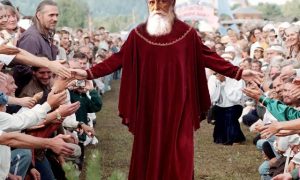The Baha’i Faith spread to the United States when a Baha’i of Lebanese Christian background, Ibrahim Kheiralla (1849–۱۹۲۹), arrived in New York in December 1892 to pursue economic opportunities. He had converted in Cairo in 1888 and knew little about Baha’u’llah‘s teachings. Kheiralla was interested in magic and Middle Eastern folk religion; in the United States he read popular books about the Bible and learned about Theosophy and reincarnation. He encountered Browne’s Baha’i publications, but used them sparingly.
In 1894 Kheiralla moved to Chicago, where he established a healing practice using the laying on of hands and the smoking of water pipes. His contacts, however, soon were more interested in his religion. They were either middle-class professionals and white-collar workers of Anglo-Saxon background or first-generation German or Scandinavian immigrants, often blue-collar workers. Some heard of Kheiralla through the Oriental Order of the Magi, an esoteric Masonic group. Others were students of alternative religions and philosophies, interests stimulated by the recent Parliament of the World’s Religions. Unlike American sympathizers of Buddhism and Hinduism, the Chicago Baha’is did not come primarily from the upper classes.
By mid-1894 at least five people became “Behaists.” Their circle of friends became attracted, and in 1895 the “First Assembly of Beha’ists in America” purchased a seal. In 1896 Kheiralla organized his teachings into two public lectures and 13 private lessons covering the purpose of existence, metaphorical interpretation of the Bible and its prophecies, and the unity of the world’s religions. The last three lessons noted that the Millerites, who expected Christ’s return in 1844, were correct; that was the year the Bab began his mission. The lessons described Baha’u’llah as the biblical return of the Father and ‘Abdu’l-Baha‘ as the return of Christ.
In the summer of 1897, Kheiralla gave his lessons to an audience of Swiss-German immigrants interested in vegetarianism, Populism, Socialism, and Christian Science in the small central Kansas village of Enterprise. In the fall blue-collar workers of Scandinavian and German background in Kenosha, Wisconsin, an industrial city 70 miles from Chicago, invited Kheiralla to give the lessons there. Chicago Baha’is who had moved to New York and New Jersey had Kheiralla give the lessons in New York City starting in January 1898. The result was a community of 200 Baha’is, mostly white-collar professionals of Anglo-Saxon background and Episcopal leanings. Other Chicagoans returned home to Philadelphia and Ithaca and taught their relatives. Expansion continued in 1898 to Racine, Wisconsin, the San Francisco area, Boston, Washington, D.C., and in 1899, to Cincinnati. By the fall of 1899 an incomplete list of Baha’is included 1467 names in 60 localities in 25 states, the District of Columbia, Ontario, England, and France.
Kheiralla responded to the growth by converting his lessons into a book, Beha’u’llah. As it neared completion, Phoebe Hearst, mother of William Randolph Hearst, became a Baha’i and decided to visit ‘Abdu’l-Baha’, and she was willing to pay Kheiralla’s travel expenses. The party left the United States in September. Most visited ‘Abdu’l-Baha’ for only three days, but Ibrahim Kheiralla and two American Baha’is, Edward and Lua Getsinger, arranged to stay in the household for six months.
The Akka Baha’is were shocked by Kheiralla’s mix of Baha’i, Theosophical, and evangelical Protestant ideas, coupled with false Arabic etymologies, bizarre interpretations of history, and two prayers allegedly by Baha’u’llah that Kheiralla had, in fact, written himself.
(Robert Stockman, Introduction to New and Alternative Religions in America)






